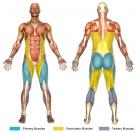Squats (Dumbbell)
- Stand erect with a dumbbell in each hand.
- Ensure that your feet are positioned correctly (generally this means either aligned parallel to one another or pointing slightly outward) and that they are about shoulder-width apart (which is preferred for standard squats).
- Slightly arch your back (by rotating your pelvis forward)--just enough so that it is not rounded, tighten your abdominals, and look forward (keeping your eyes fixed on a distant object to best maintain balance).
- If utilizing the blocking procedure, inhale fully (as dictated by the blocking procedure explained below in "Things To Look Out For"), and squat downward by slowly sitting until your thighs are horizontal to the floor. (If you're not utilizing the blocking procedure you may inhale throughout the entire downward/lowering portion of the movement.)
- Push with your legs until the initial upright position is once again assumed. Exhale. (If not utilizing the blocking procedure you may exhale throughout the entire upward portion of the movement.)
- Repeat steps 4-5 for as many repetitions as are desired.
Typically dumbbell squats are done with equivalently lighter weights than barbell squats.
Dumbbell squats are a nice alternative exercise for individuals who experience complications with the bar placement that barbell squats requires (such as pain or inability to have a bar across the traps/shoulders). Complications associated with the bar placement of barbell squats are removed with dumbbell squats, as a bar is not across the traps/shoulders; instead, one dumbbell hangs at side of the body alongside the legs.
Another distinctive aspect of this exercise is that by slightly moving the weights forward or backward additional balancing effects can be attained. However, this method should not be relied upon for balance, though it may be utilized to tweak balance.
Foot placement is very important with squats and correct placement will vary individual to individual. The key is to maintain knee and feet alignment as much as possible. For some this will be achieved by pointing the feet directly forward and for others the feet may point outward. If your not sure which way is best for you, note the manner in which you walk. If your natural gait has your feet pointing outward, then that's probably the best position for you. It's inevitable that during the squatting motion the feet and knees won't maintain exact alignment, but, as always, do keep your form as good as possible, and experiment to see which placement best suits your unique physical structure.
It's worth noting that hamstring recruitment happens mostly after the squat falls below parallel. At this point, the gluteal muscles become more involved yet, as well. Squats are undoubtedly one of the best exercise for buttocks (gluteal) development, too.
Differences in anatomy, such as long femurs or inflexible ankles, can cause difficulties in properly performing squats. In these cases, individuals have a tendency to tilt the torso forward too much, which is highly undesirable because it can lead to injuries (primarily of the knees and back). Luckily, there are methods that allow for easier, better performed squatting. Those with long legs (in relation to the torso) or inflexible ankles can simply place a block of some sort under their heels. The block can be specially made out of wood, for instance, or it can be more rudimentary, such as a weight plate (or two). The width of the block depends on the individual's preference, but generally a one inch block will be sufficient. Experiment to find what works best for you. Do note, however, that placing a block under one's heels causes more quadriceps isolation. A heel block helps by creating more natural balance (which helps prevent one's torso from moving too far forward), and by preventing one's knees from moving too far forward (out of alignment with one's feet).
Another helpful option for those with long legs or inflexible ankles is to use the Smith machine. The Smith machine consists of a rigid frame with a track on it that only allows for strict vertical motion. This way, as long as the feet are placed in a proper location below it, knee and back injuries are much less likely to occur.
Don't round your back! Use "blocking" to help avoid doing so.
A "Block" or "Blocking":
Blocking is used to create a rigid core. A rigid core both improves strength and helps to prevent injury. It is best utilized and absolutely recommended whenever heavy weights are involved. The goal of blocking is to keep rounding of the back (vertebral flexion) at bay. There are 3 aspects to achieving a block. They are:
- Deeply inhale prior to the effort and hold this inhalation until the end of the effort. Deep inhalation causes chest expansion by filling the lungs with oxygen. This prevents the chest from collapsing forward when the body is being subjected to heavy weight-lifting.
- Contract your abdominal muscles throughout the effort. The increased intra-abdominal pressure enhances core support by essentially preventing the torso from collapsing forward.
- Contract your lumbar (lower back) muscles. This will keep a slight arch in the lower back. The point is to keep the spinal column in extension.
For those with knee problems, it is important to be sure that the knees and feet maintain relative alignment with one another. Read "Further Clarification" above for a thorough explanation of how to do so.





